Domain organization of the polymerizing mannosyltransferases involved in synthesis of the Escherichia coli O8 and O9a lipopolysaccharide O-antigens
- PMID: 22989876
- PMCID: PMC3488083
- DOI: 10.1074/jbc.M112.412577
Domain organization of the polymerizing mannosyltransferases involved in synthesis of the Escherichia coli O8 and O9a lipopolysaccharide O-antigens
Abstract
The Escherichia coli O9a and O8 polymannose O-polysaccharides (O-PSs) serve as model systems for the biosynthesis of bacterial polysaccharides by ATP-binding cassette transporter-dependent pathways. Both O-PSs contain a conserved primer-adaptor domain at the reducing terminus and a serotype-specific repeat unit domain. The repeat unit domain is polymerized by the serotype-specific WbdA mannosyltransferase. In serotype O9a, WbdA is a bifunctional α-(1→2)-, α-(1→3)-mannosyltransferase, and its counterpart in serotype O8 is trifunctional (α-(1→2), α-(1→3), and β-(1→2)). Little is known about the detailed structures or mechanisms of action of the WbdA polymerases, and here we establish that they are multidomain enzymes. WbdA(O9a) contains two separable and functionally active domains, whereas WbdA(O8) possesses three. In WbdC(O9a) and WbdB(O9a), substitution of the first Glu of the EX(7)E motif had detrimental effects on the enzyme activity, whereas substitution of the second had no significant effect on activity in vivo. Mutation of the Glu residues in the EX(7)E motif of the N-terminal WbdA(O9a) domain resulted in WbdA variants unable to synthesize O-PS. In contrast, mutation of the Glu residues in the motif of the C-terminal WbdA(O9a) domain generated an enzyme capable of synthesizing an altered O-PS repeat unit consisting of only α-(1→2) linkages. In vitro assays with synthetic acceptors unequivocally confirmed that the N-terminal domain of WbdA(O9a) possesses α-(1→2)-mannosyltransferase activity. Together, these studies form a framework for detailed structure-function studies on individual domains and a strategy applicable for dissection and analysis of other multidomain glycosyltransferases.
Figures

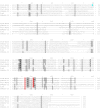



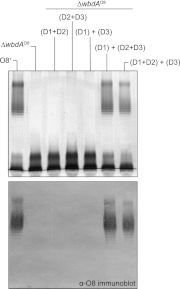

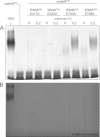

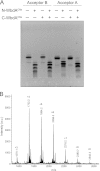
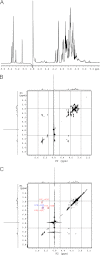
Similar articles
-
Biosynthesis of the polymannose lipopolysaccharide O-antigens from Escherichia coli serotypes O8 and O9a requires a unique combination of single- and multiple-active site mannosyltransferases.J Biol Chem. 2012 Oct 12;287(42):35078-35091. doi: 10.1074/jbc.M112.401000. Epub 2012 Aug 8. J Biol Chem. 2012. PMID: 22875852 Free PMC article.
-
Domain interactions control complex formation and polymerase specificity in the biosynthesis of the Escherichia coli O9a antigen.J Biol Chem. 2015 Jan 9;290(2):1075-85. doi: 10.1074/jbc.M114.622480. Epub 2014 Nov 24. J Biol Chem. 2015. PMID: 25422321 Free PMC article.
-
A single amino acid substitution in a mannosyltransferase, WbdA, converts the Escherichia coli O9 polysaccharide into O9a: generation of a new O-serotype group.J Bacteriol. 2000 May;182(9):2567-73. doi: 10.1128/JB.182.9.2567-2573.2000. J Bacteriol. 2000. PMID: 10762260 Free PMC article.
-
Synthesis of Escherichia coli O9a polysaccharide requires the participation of two domains of WbdA, a mannosyltransferase encoded within the wb* gene cluster.Mol Microbiol. 1998 Mar;27(6):1213-21. doi: 10.1046/j.1365-2958.1998.00765.x. Mol Microbiol. 1998. PMID: 9570406
-
Synthesis of lipopolysaccharide O-antigens by ABC transporter-dependent pathways.Carbohydr Res. 2012 Jul 15;356:12-24. doi: 10.1016/j.carres.2012.02.027. Epub 2012 Mar 6. Carbohydr Res. 2012. PMID: 22475157 Review.
Cited by
-
Substrate recognition by a carbohydrate-binding module in the prototypical ABC transporter for lipopolysaccharide O-antigen from Escherichia coli O9a.J Biol Chem. 2019 Oct 11;294(41):14978-14990. doi: 10.1074/jbc.RA119.010323. Epub 2019 Aug 15. J Biol Chem. 2019. PMID: 31416837 Free PMC article.
-
The diversity of Klebsiella pneumoniae surface polysaccharides.Microb Genom. 2016 Aug 25;2(8):e000073. doi: 10.1099/mgen.0.000073. eCollection 2016 Aug. Microb Genom. 2016. PMID: 28348868 Free PMC article.
-
A bifunctional O-antigen polymerase structure reveals a new glycosyltransferase family.Nat Chem Biol. 2020 Apr;16(4):450-457. doi: 10.1038/s41589-020-0494-0. Epub 2020 Mar 9. Nat Chem Biol. 2020. PMID: 32152541
-
Engineering the product profile of a polysialyltransferase.Nat Chem Biol. 2014 Jun;10(6):437-42. doi: 10.1038/nchembio.1501. Epub 2014 Apr 13. Nat Chem Biol. 2014. PMID: 24727899
-
Lipopolysaccharide O-antigens-bacterial glycans made to measure.J Biol Chem. 2020 Jul 31;295(31):10593-10609. doi: 10.1074/jbc.REV120.009402. Epub 2020 May 18. J Biol Chem. 2020. PMID: 32424042 Free PMC article. Review.
References
-
- Stenutz R., Weintraub A., Widmalm G. (2006) The structures of Escherichia coli O-polysaccharide antigens. FEMS Microbiol. Rev. 30, 382–403 - PubMed
-
- Sperandeo P., Dehò G., Polissi A. (2009) The lipopolysaccharide transport system of Gram-negative bacteria. Biochim. Biophys. Acta 1791, 594–602 - PubMed
Publication types
MeSH terms
Substances
LinkOut - more resources
Full Text Sources
Other Literature Sources
Molecular Biology Databases

